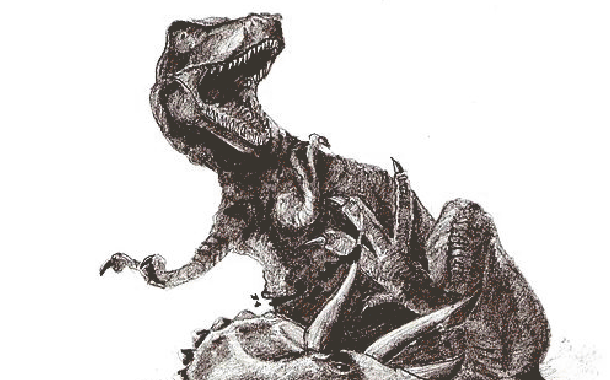<![CDATA[According to a study recently published in the journal 'Science', scientists have discovered a dinosaur far larger and maybe even scarier than the Tyrannosaurus Rex. This dinosaur ate fish and is the first water-adapted non-avian dinosaur ever to be discovered. The species is known as "Spinosaurus aegyptiacus", and may have looked like a cross between a duck and a crocodile with large spikes on its back. It is thought to have grown to up to 50 feet long, and lived in North America about 95 million years ago. The dinosaur adapted to live both on land and in water. The study was headed by Nizar Ibrahim, from the department of Organismal Biology and Anatomy at the University of Chicago. At a recent press conference in Chicago, he explained that the species was first named in 1915 by Ernst Stromer, a German palaeontologist. Stromer found some bizarre backbones with spines that he described as being as tall as a person. Stromer didn't have enough information to judge the real magnitude of the dinosaur, and his findings were destroyed in 1944 by a Royal Air Force raid over Munich. He had a hunch that the species was larger than the T-Rex. Last year, Ibrahim and his team found some "Spinosaurus" bones in Morocco. They were investigating the region after a local had reported finding a finger bone and spine. The team found vertebrae, teeth, and jaw pieces. With the help of 3D modelling they were able to make a sketch of the gigantic dinosaur. Its 50-feet length made it 9 to 10 feet longer than a typical T-Rex. This semi-aquatic creature ate sharks, and had a snout akin to a crocodile which enabled it to sense any movement happening under water. It had very sharp teeth, which enabled it to gnaw down on very large fish. The most striking feature of the Spinosaurus was the huge sail-like dorsal fin on its back. The story behind how the bones got there in the first place is mostly luck. The person who found the finger bone and spine had actually first met Ibrahim five years earlier. The amateur collector was conducting research for his PhD, and brought the bones to Ibrahim and asked him if he could identify them. Ibrahim said he would get back to him, but without knowing where the bones came from, he couldn't figure out what they were. It wasn't until five years later that Ibrahim bumped into him again in the streets of Erfoud. After reacquainting, the man took Ibrahim and his team to the place where he had found the bones. A replica of the enormous dinosaur is on display at the National Geographic Museum. The first thing to greet you at the exhibit is the finger and the spine, deeper into the exhibit is the enormous skeletal display. Now, the scientists are hoping to use the information they have to figure out how the dinosaur moved on land, as well as in the sea.]]>
New Dinosaur Species Usurps Tyrannosaurus Rex as Largest Predator
